 French Navy (1962-95), T56 design, D638
French Navy (1962-95), T56 design, D638
The
T53 (Duperré) class destroyers succeeded to the the T47 or (
Surcouf class), five being built before developments on missiles urged the conversion of what became the first French missile destroyer, La Galissonnière (1960), sole of the T56 class, initially the 6th of these. They were testbeds before the construction of large guided missile destroyers in the late 1960s, the Suffren class.
Origins and Modifications
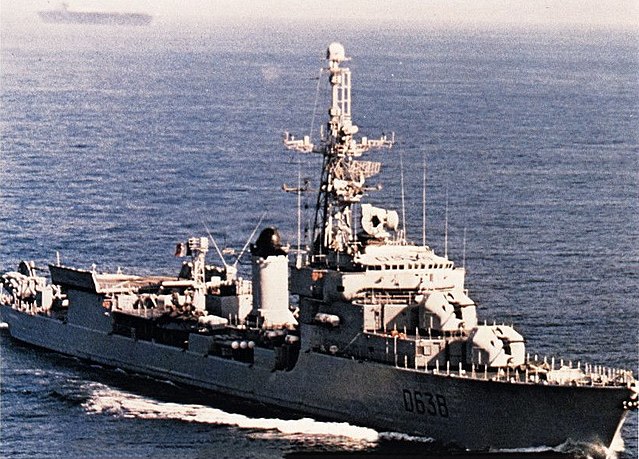
Compared to the T47, the T53 differed in having improved electronics, increase capabilities for tracking and controlling aircraft, improved air search radar and increased ASW capability. They still ended modified in the 1960-70s, the lead ship Duperré being completely rebuilt and active until 1992, and the remainder until 1976-81. D 638, ordered as the sixth of the class was requisitioned as the Navy looked for a platform to test its latest ASW weapon, the Malafon missile. Both only that but she had modified superstructures, a new collapsible hangar aft for an helicopter, and the brand new Model 1953 100 mm (4 in) gun.
The unique T56 destroyer was named after Roland-Michel Barrin de La Galissonière, French Louis XV admiral, Viceroy of New France (Canada and the Mississippi valley down to Louisiana) and general naval commander (November 1693-October 1756). She was built at Arsenal de Lorient, launched on 11 July 1962, decommissioned on 20 April 1990 after 28 years, scrapped in Ghent, Belgium, 2015.
The ultimate evolution of the squadron escort, series 4, she was the first combat vessel fitted with the new French Malafon anti-submarine weapon system, as well as using low frequency acoustic detection sensors (under 5 kHz) as well as a towed, variable immersion sonar (VDS). La Galissonnière foreshadowed ships that followed it, as well as French AWM corvettes/frigates of the 1970-80s.
The level of her transformations is impressive and was gradual.
Design
Hull and Powerplant
She was another T-53 destroyer as far as the hull was concerned, however it was made in 84 section for a total mass of 1100 t, divided into 17 bulkheaded compartments listed from A to Q (front to back). She displaced 2,750t standard and 3,740t fully loaded, so more than regular T53 ships, for a greater overall lenght of 132.8 meters, same 12.7 meters in beam but 5.40m in draught. Her prow was longer and "clipper-style", she had no portholes, had two shafts driven by two sets of Rateau geared steam turbines fed by four Indret boilers for a total of 63,000 shp. It seems the powerplant was improved and the longer, better shaped hull helped to achieve the best performances of all T53 destroyers.
On trials she was capable of reaching 34 knots, reduced to 30 in normal use. She carried 800 tonnes of oil, enough for a 5,000 km range at 18 knots.
The greatest changes were for her general appearance. Unlike the T53, she had a reworked forward sructure to carry the two DP guns, the bridge was taller, wider and pushed aft. She had a simple derrick mast to support most main aerials, and two capped funnels.
The torpedo tubes banks were located abaft the second funnel. The 12-in ASW rocket launcher was installed on the upper deck aft of it, centerline. Next was the hangar/helispot platform. Aft of it was located the main Malafon missile launcher and reload. The poop was modified to host the VDS system.
Weapons systems
Malafon ASW Missile
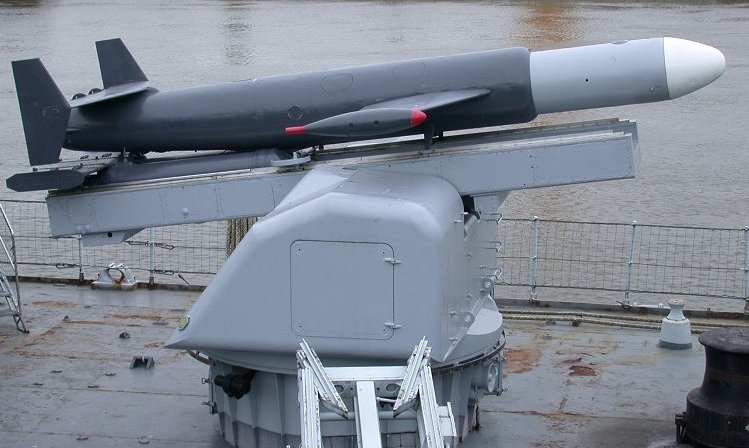
Fed by data coming from pointing computers linked to the sonars, the Malafon system included a single launcher arm and hold below containing 13 spare missiles, radar-guided during initial flight. The glider dropped a homing torpedo near the target. The latter is the 450mm (18 in) L4 torpedo. The launcher had a full traverse but fired at a fixed elevation of +15°. Two solid booster rockets accelerate it to 830 km/h (520 mph) in 4 seconds, after which it's in free flight until the target, from an altitude of 100 metres (330 ft), altering course mid-flight thanks to radio control. The Malafon has an Effective range of 13 km (8.1 mi) comparable to ASROC. As it reaches the target, the torpedo splashes and starts a circular search pattern, circa 800 metres (2,600 ft) of the submarine's location. The L4 torpedo then homes to target at 30 knots (56 km/h; 35 mph) over a range of 5 km (3.1 mi).
The 1,330 kg (2,930 lb) Malafon however was a cumbersome weapon, only installed on large escort ships, not frigates. It could be setup also against surface ships.
Torpedo Tubes
In addition to the Malafon system, the La Galissonnière had six torpedo tubes, two triple banks with standard 533 mm (21-in) heavyweight torpedoes. L3 Torpedo (1960), a 2,006 lbs. (910 kg), 170.1 in (4.320 m) model carrying a 440 lbs. (200 kg) Tolite A1 warhead, 5,500 yards (5,000 m)/25 knots powered by a Nickel-cadmium Battery. This was the standard Acoustic-homing anti-submarine torpedo of the sixties (600 manufactured).
ASW Mortar
For anti-submarine warfare, the quadruple 305 mm (12-in) self-loading mortar launched 230 kg ASW charges from 400 to 3000 meters in range. The mortar also had a firing capability against ground targets with a lighter projectile (100 kg) but at a 6000 m range. See the T53 class for more details.
2x 100mm Gun M53
For surface and AA fire, she was given from the start two 100 mm automatic cannon M1953 made by Creusot-Loire, in superfiring positions forward. This gun became the go-to standard of the French Navy until the late 1990s. If the model 64 was installed, it was capable of 72 rpm, versus the initial 60 rpm for the M1957, and between 6 000 and 12,000 m in ceiling and range.
Helicopter
The La Galissonnière had quite a unique helicopter platform convertible after folding up into a small hangar. It was strong egough to dupport an Alouette II helicopter, then an Alouette III. This solution however remained unique to this ship: The hangar was too cramped to perform maintenance in a satisfactory way, not to store any parts. In French naval service the Aérospatiale Alouette II (1956) was used for ASW tracking and SAR, liaison. It could carry aerial torpedoes for ASW. The 1965 Alouette III had a fully enclosed fuselage and performed the same missions.
After her 1972 refit, the aft collapsible hangar was removed and a permament helipad deck installed, meaning the helicopter was no longer resident.
Sensors
Initially La Galissonière experimented the following sonars suites:
-Bow sonar array SQS 503 transducer with M.F.7,8,9 panoramic scan and search sonar, provides data for the Malafon
-One DUBA-3 hoisted dome MCS3B sonar, on TOP-9 a M.F.11,12 transducer: This was the attack sonar, suitable for short-range ASW, indicating target depht.
-One SQS 503 dome hoistable sonar MCS4A, same as the one in the bow
-One VDS (towed array 13 AN/SQS/1014 to work in isothermal region, offering better ultrasonic rays propagation.
-The SQS-503 panoramic sonar had approximately three times more detection range than the other systems carried and was 20x more powerful than conventional HF escort sonars in service at the time.
-Later it was replaced by a DUBV-2315 bow sonar using low frequencies
-Towed sonar VDS, low frequencies, DUBV-4315
Above surface Radars/FCR
-One combined Air-Surface surveillance radar DRBV 22A
-One DRBV 50 surface monitoring and navigation radar
-One main fire control radar (artillery) DRBC 32A
-One DRBN 32 navigation radar
-One Tacan beacon (SRN 6)

⚙ T53 La Galissonière specifications (as completed, 1963) |
| Displacement | 2,750t standard, 3,740t full load |
| Dimensions | 128.6 x 12.7 x 5.4 m (421 ft 11 in x (41 ft 8 in x 17 ft 9 in) |
| Propulsion | 2 shafts, 4 Geared turbines, 4 boilers, 63,000 hp (46,979 kW) |
| Speed | 34 knots (63 km/h; 39 mph) |
| Range | 5,000 nmi (9,300 km; 5,800 mi) at 18 kn (33 km/h; 21 mph) |
| Armament | malafon ASWM(13), 2× 100 mm DP, 2× 20 mm, 1×4 305 mm ASWRL, 2x3 550 mm TTs |
| Air Group | 1x Alouette II, later Alouette III helicopter |
| Sensors | DRBV31 ASR, 2x DRBC30 FCR, DRBI10B AR, DRBV22A CSR, DUBV/SUBA 1B sonars |
| Crew | 272: 19 officers, 253 enlisted |
Read More/Src
Books
Conway's all the world's fighting ships 1947-1995
Jean Moulin et Robert Dumas, Les Escorteurs d'escadre, Marines éditions Nantes 1997
Jean Meyer et Martine Acerra, Histoire de la marine française des origines à nos jours. Ouest-France 1994
Michel Vergé-Franceschi (dir.), Dictionnaire d'Histoire maritime. Robert Laffont, 2002
Alain Boulaire, La Marine française: De la Royale de Richelieu aux missions d'aujourd'hui, Quimper, Palantines Ed. 2011
Rémi Monaque, Une histoire de la marine de guerre française, Paris, Perrin Ed.
Links
on herve.toudic.free.fr
on netmarine.net/
on navypedia.org
on seaforces.org/
photo gallery on netmarine.net/
fr.wikipedia.org/
Career of La Galissonnière
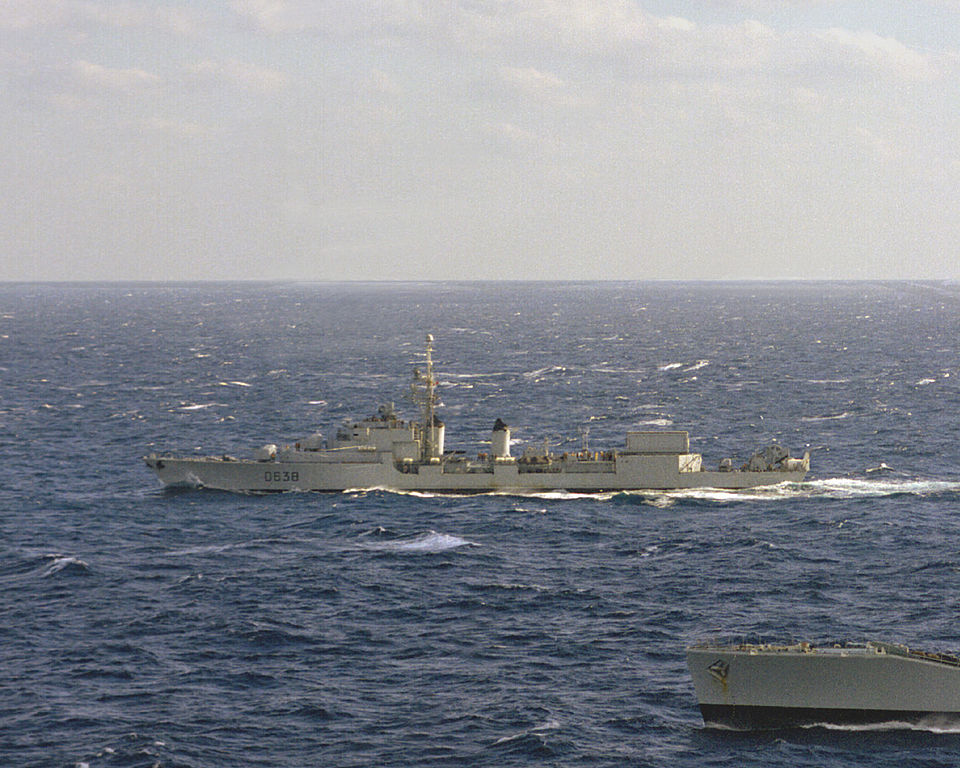 La Galissonnière and HMS Scylla in 1978
La Galissonnière and HMS Scylla in 1978
The ship was laid down as "escorteur d'escadre anti-sous-marin" (ASWsquadron escort). She was laid down on november 1958, launched on 12 march 1960, commissioned on 9 juillet 1962 as experimental ship. In full speed trials on july 1960, she performed the best of all T53 destroyer with a total output of 72,555 shp. The ship became famous as the testbed for the French Malafon system ahd having an helicopter hangar with folding up panels that can be converted as a landing deck.
During her first seven years of service, the La Galissonnière was mainly used to test new types of sonars, in particular towed sonars with variable immersion.
She visited the following between 1961 and 1972 (and her major refit): Lorient, Brest, Cherbourg, Dakar, Santa Cruz, Mers el Kébir, Haïfa, Barcelona, Livorno, Naples, Ajaccio, Lisbonne, Gibraltar, Cannes, Sétubal, Vigo, Kotor, Monaco, Palermo, Calvi, Santa Pola, Palma de Majorca, Funchal.
In 1970 she made a cross atlantic crossing to the US, visiting Hamilton, Norfolk, Halifax, and on her way back Ponta Delgada (Azores), Athènes, Naxos, Syros, Tinos, Messina. The next year she visited Malta, Casablanca, Kalamata and Naples again.
 Same as above, larger (not cropped), from NARA open source funds.
Same as above, larger (not cropped), from NARA open source funds.
In 1972 she had her "Grand carénage", her major mid-life refit. She had her electronics refreshed, and her quad 12-in (305 mm) ASWRL removed. In its place she received the ARBR/ARBA-10C ECM suite.
In 1973 she visited Croatia (Yugoslavioa then) and Dubrovnik, Augusta, Piraues and La Spezia and next year Tanger, Suda, Beyrouth then in 1975 Carthagena, Athenes, Corfu, Marseille. In 1978 she visited Heraklion, Venice, Djibouti, Port Victoria, Abu Dhabi and Cochin. In 1980 she visited Split, Tunis, Djibouti and transitioned to the Indian Ocean, visiting Mayotte, Moroni, Mogadiscio, Hodeidah, and back to Port Saïd.
From 1982 she stayed on the Mediterranean, going from La Maddalena, to Sfax, Venise and Tarente, Constanza (Romania), Salonica or Beyrouth.
From 1983 she was assigned among other things the protection and security of deployments ("dilution") of French SSBNs (nuclear ballistic missile submarines). This year she visited Larnaca, Genoa, but transited to Brest as new homeport, and visited Malaga.
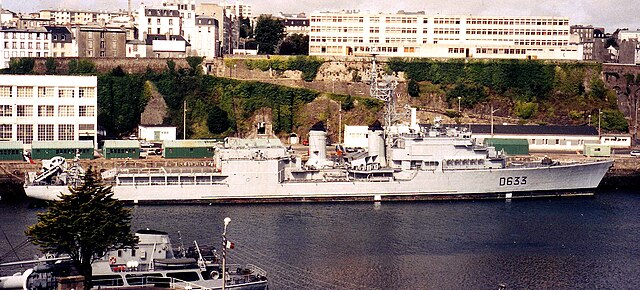 The Duperré being disarmed. Note she had a VDS, exocet canisters, helicopter deck and hangar after reconstruction.
The Duperré being disarmed. Note she had a VDS, exocet canisters, helicopter deck and hangar after reconstruction.
In 1984 she stayed in north European waters and visited Anvers, Belgium. The next year she ventured along the African West coast, from Santa Cruz de Ténériffe to Pointe Noire, Abidjan, Freetown, and back to Dunkerque, then she transited to the Mediterranea, Toulon base, visiting Casablanca. In 1986 she went back to this two seas transitions, visiting Kiel for the first time and later El Ferrol Yard. In 1987 she took part in NATO exercizes in the north sea and Atlantic, visiting Rosyth, Vigo, Royan, Portsmouth, Cardiff and Rotterdam. In 1988 she went to Devonport and Leixoes. In 1989 she visited Recife, Pointe-à-Pitre in the West Indies as well as Saint Martin, and when back, Lisbonne, Bayonne and Devonport. In 1990, her last active year, she entered the Garonne river and dropped anchor at Bordeaux, and later visited La Pallice and Cadix.
She was eventually decommissioned on April 20, 1990, and retook the hull number Q 682, first used as a breakwater for the Naval Academy at NAS Lanvéoc-Poulmic. Then her hull was gutted and transferred in 2006 to the Landévennec cemetery. On May 21, 2015, she was returned to Brest, prepared for her transfer on June 12, 2015, to Ghent shipyard in Belgium, sokld for scrap to Galloo Group.
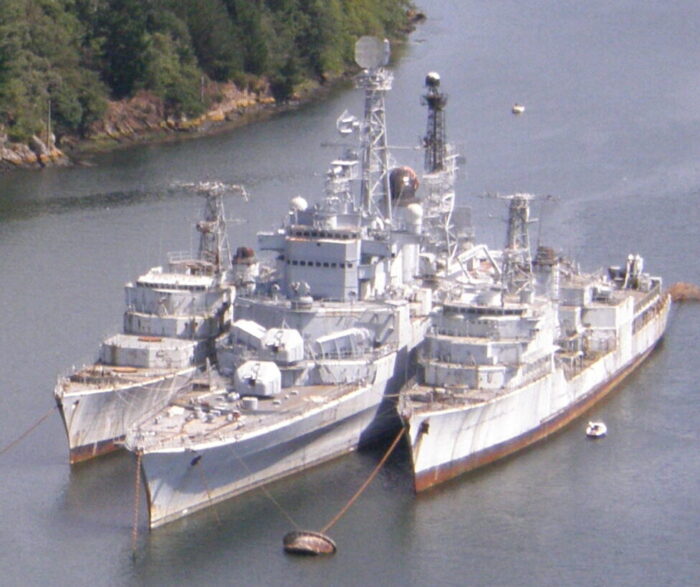 Pending her fate at Landevenec, berthed with Colbert in 2006-2015.
Pending her fate at Landevenec, berthed with Colbert in 2006-2015.
 Compared to the T47, the T53 differed in having improved electronics, increase capabilities for tracking and controlling aircraft, improved air search radar and increased ASW capability. They still ended modified in the 1960-70s, the lead ship Duperré being completely rebuilt and active until 1992, and the remainder until 1976-81. D 638, ordered as the sixth of the class was requisitioned as the Navy looked for a platform to test its latest ASW weapon, the Malafon missile. Both only that but she had modified superstructures, a new collapsible hangar aft for an helicopter, and the brand new Model 1953 100 mm (4 in) gun.
The unique T56 destroyer was named after Roland-Michel Barrin de La Galissonière, French Louis XV admiral, Viceroy of New France (Canada and the Mississippi valley down to Louisiana) and general naval commander (November 1693-October 1756). She was built at Arsenal de Lorient, launched on 11 July 1962, decommissioned on 20 April 1990 after 28 years, scrapped in Ghent, Belgium, 2015.
The ultimate evolution of the squadron escort, series 4, she was the first combat vessel fitted with the new French Malafon anti-submarine weapon system, as well as using low frequency acoustic detection sensors (under 5 kHz) as well as a towed, variable immersion sonar (VDS). La Galissonnière foreshadowed ships that followed it, as well as French AWM corvettes/frigates of the 1970-80s.
The level of her transformations is impressive and was gradual.
Compared to the T47, the T53 differed in having improved electronics, increase capabilities for tracking and controlling aircraft, improved air search radar and increased ASW capability. They still ended modified in the 1960-70s, the lead ship Duperré being completely rebuilt and active until 1992, and the remainder until 1976-81. D 638, ordered as the sixth of the class was requisitioned as the Navy looked for a platform to test its latest ASW weapon, the Malafon missile. Both only that but she had modified superstructures, a new collapsible hangar aft for an helicopter, and the brand new Model 1953 100 mm (4 in) gun.
The unique T56 destroyer was named after Roland-Michel Barrin de La Galissonière, French Louis XV admiral, Viceroy of New France (Canada and the Mississippi valley down to Louisiana) and general naval commander (November 1693-October 1756). She was built at Arsenal de Lorient, launched on 11 July 1962, decommissioned on 20 April 1990 after 28 years, scrapped in Ghent, Belgium, 2015.
The ultimate evolution of the squadron escort, series 4, she was the first combat vessel fitted with the new French Malafon anti-submarine weapon system, as well as using low frequency acoustic detection sensors (under 5 kHz) as well as a towed, variable immersion sonar (VDS). La Galissonnière foreshadowed ships that followed it, as well as French AWM corvettes/frigates of the 1970-80s.
The level of her transformations is impressive and was gradual.
 Fed by data coming from pointing computers linked to the sonars, the Malafon system included a single launcher arm and hold below containing 13 spare missiles, radar-guided during initial flight. The glider dropped a homing torpedo near the target. The latter is the 450mm (18 in) L4 torpedo. The launcher had a full traverse but fired at a fixed elevation of +15°. Two solid booster rockets accelerate it to 830 km/h (520 mph) in 4 seconds, after which it's in free flight until the target, from an altitude of 100 metres (330 ft), altering course mid-flight thanks to radio control. The Malafon has an Effective range of 13 km (8.1 mi) comparable to ASROC. As it reaches the target, the torpedo splashes and starts a circular search pattern, circa 800 metres (2,600 ft) of the submarine's location. The L4 torpedo then homes to target at 30 knots (56 km/h; 35 mph) over a range of 5 km (3.1 mi).
The 1,330 kg (2,930 lb) Malafon however was a cumbersome weapon, only installed on large escort ships, not frigates. It could be setup also against surface ships.
Fed by data coming from pointing computers linked to the sonars, the Malafon system included a single launcher arm and hold below containing 13 spare missiles, radar-guided during initial flight. The glider dropped a homing torpedo near the target. The latter is the 450mm (18 in) L4 torpedo. The launcher had a full traverse but fired at a fixed elevation of +15°. Two solid booster rockets accelerate it to 830 km/h (520 mph) in 4 seconds, after which it's in free flight until the target, from an altitude of 100 metres (330 ft), altering course mid-flight thanks to radio control. The Malafon has an Effective range of 13 km (8.1 mi) comparable to ASROC. As it reaches the target, the torpedo splashes and starts a circular search pattern, circa 800 metres (2,600 ft) of the submarine's location. The L4 torpedo then homes to target at 30 knots (56 km/h; 35 mph) over a range of 5 km (3.1 mi).
The 1,330 kg (2,930 lb) Malafon however was a cumbersome weapon, only installed on large escort ships, not frigates. It could be setup also against surface ships.


 La Galissonnière and HMS Scylla in 1978
The ship was laid down as "escorteur d'escadre anti-sous-marin" (ASWsquadron escort). She was laid down on november 1958, launched on 12 march 1960, commissioned on 9 juillet 1962 as experimental ship. In full speed trials on july 1960, she performed the best of all T53 destroyer with a total output of 72,555 shp. The ship became famous as the testbed for the French Malafon system ahd having an helicopter hangar with folding up panels that can be converted as a landing deck.
During her first seven years of service, the La Galissonnière was mainly used to test new types of sonars, in particular towed sonars with variable immersion.
She visited the following between 1961 and 1972 (and her major refit): Lorient, Brest, Cherbourg, Dakar, Santa Cruz, Mers el Kébir, Haïfa, Barcelona, Livorno, Naples, Ajaccio, Lisbonne, Gibraltar, Cannes, Sétubal, Vigo, Kotor, Monaco, Palermo, Calvi, Santa Pola, Palma de Majorca, Funchal.
In 1970 she made a cross atlantic crossing to the US, visiting Hamilton, Norfolk, Halifax, and on her way back Ponta Delgada (Azores), Athènes, Naxos, Syros, Tinos, Messina. The next year she visited Malta, Casablanca, Kalamata and Naples again.
La Galissonnière and HMS Scylla in 1978
The ship was laid down as "escorteur d'escadre anti-sous-marin" (ASWsquadron escort). She was laid down on november 1958, launched on 12 march 1960, commissioned on 9 juillet 1962 as experimental ship. In full speed trials on july 1960, she performed the best of all T53 destroyer with a total output of 72,555 shp. The ship became famous as the testbed for the French Malafon system ahd having an helicopter hangar with folding up panels that can be converted as a landing deck.
During her first seven years of service, the La Galissonnière was mainly used to test new types of sonars, in particular towed sonars with variable immersion.
She visited the following between 1961 and 1972 (and her major refit): Lorient, Brest, Cherbourg, Dakar, Santa Cruz, Mers el Kébir, Haïfa, Barcelona, Livorno, Naples, Ajaccio, Lisbonne, Gibraltar, Cannes, Sétubal, Vigo, Kotor, Monaco, Palermo, Calvi, Santa Pola, Palma de Majorca, Funchal.
In 1970 she made a cross atlantic crossing to the US, visiting Hamilton, Norfolk, Halifax, and on her way back Ponta Delgada (Azores), Athènes, Naxos, Syros, Tinos, Messina. The next year she visited Malta, Casablanca, Kalamata and Naples again.
 Same as above, larger (not cropped), from NARA open source funds.
In 1972 she had her "Grand carénage", her major mid-life refit. She had her electronics refreshed, and her quad 12-in (305 mm) ASWRL removed. In its place she received the ARBR/ARBA-10C ECM suite.
In 1973 she visited Croatia (Yugoslavioa then) and Dubrovnik, Augusta, Piraues and La Spezia and next year Tanger, Suda, Beyrouth then in 1975 Carthagena, Athenes, Corfu, Marseille. In 1978 she visited Heraklion, Venice, Djibouti, Port Victoria, Abu Dhabi and Cochin. In 1980 she visited Split, Tunis, Djibouti and transitioned to the Indian Ocean, visiting Mayotte, Moroni, Mogadiscio, Hodeidah, and back to Port Saïd.
From 1982 she stayed on the Mediterranean, going from La Maddalena, to Sfax, Venise and Tarente, Constanza (Romania), Salonica or Beyrouth.
From 1983 she was assigned among other things the protection and security of deployments ("dilution") of French SSBNs (nuclear ballistic missile submarines). This year she visited Larnaca, Genoa, but transited to Brest as new homeport, and visited Malaga.
Same as above, larger (not cropped), from NARA open source funds.
In 1972 she had her "Grand carénage", her major mid-life refit. She had her electronics refreshed, and her quad 12-in (305 mm) ASWRL removed. In its place she received the ARBR/ARBA-10C ECM suite.
In 1973 she visited Croatia (Yugoslavioa then) and Dubrovnik, Augusta, Piraues and La Spezia and next year Tanger, Suda, Beyrouth then in 1975 Carthagena, Athenes, Corfu, Marseille. In 1978 she visited Heraklion, Venice, Djibouti, Port Victoria, Abu Dhabi and Cochin. In 1980 she visited Split, Tunis, Djibouti and transitioned to the Indian Ocean, visiting Mayotte, Moroni, Mogadiscio, Hodeidah, and back to Port Saïd.
From 1982 she stayed on the Mediterranean, going from La Maddalena, to Sfax, Venise and Tarente, Constanza (Romania), Salonica or Beyrouth.
From 1983 she was assigned among other things the protection and security of deployments ("dilution") of French SSBNs (nuclear ballistic missile submarines). This year she visited Larnaca, Genoa, but transited to Brest as new homeport, and visited Malaga.
 The Duperré being disarmed. Note she had a VDS, exocet canisters, helicopter deck and hangar after reconstruction.
In 1984 she stayed in north European waters and visited Anvers, Belgium. The next year she ventured along the African West coast, from Santa Cruz de Ténériffe to Pointe Noire, Abidjan, Freetown, and back to Dunkerque, then she transited to the Mediterranea, Toulon base, visiting Casablanca. In 1986 she went back to this two seas transitions, visiting Kiel for the first time and later El Ferrol Yard. In 1987 she took part in NATO exercizes in the north sea and Atlantic, visiting Rosyth, Vigo, Royan, Portsmouth, Cardiff and Rotterdam. In 1988 she went to Devonport and Leixoes. In 1989 she visited Recife, Pointe-à-Pitre in the West Indies as well as Saint Martin, and when back, Lisbonne, Bayonne and Devonport. In 1990, her last active year, she entered the Garonne river and dropped anchor at Bordeaux, and later visited La Pallice and Cadix.
She was eventually decommissioned on April 20, 1990, and retook the hull number Q 682, first used as a breakwater for the Naval Academy at NAS Lanvéoc-Poulmic. Then her hull was gutted and transferred in 2006 to the Landévennec cemetery. On May 21, 2015, she was returned to Brest, prepared for her transfer on June 12, 2015, to Ghent shipyard in Belgium, sokld for scrap to Galloo Group.
The Duperré being disarmed. Note she had a VDS, exocet canisters, helicopter deck and hangar after reconstruction.
In 1984 she stayed in north European waters and visited Anvers, Belgium. The next year she ventured along the African West coast, from Santa Cruz de Ténériffe to Pointe Noire, Abidjan, Freetown, and back to Dunkerque, then she transited to the Mediterranea, Toulon base, visiting Casablanca. In 1986 she went back to this two seas transitions, visiting Kiel for the first time and later El Ferrol Yard. In 1987 she took part in NATO exercizes in the north sea and Atlantic, visiting Rosyth, Vigo, Royan, Portsmouth, Cardiff and Rotterdam. In 1988 she went to Devonport and Leixoes. In 1989 she visited Recife, Pointe-à-Pitre in the West Indies as well as Saint Martin, and when back, Lisbonne, Bayonne and Devonport. In 1990, her last active year, she entered the Garonne river and dropped anchor at Bordeaux, and later visited La Pallice and Cadix.
She was eventually decommissioned on April 20, 1990, and retook the hull number Q 682, first used as a breakwater for the Naval Academy at NAS Lanvéoc-Poulmic. Then her hull was gutted and transferred in 2006 to the Landévennec cemetery. On May 21, 2015, she was returned to Brest, prepared for her transfer on June 12, 2015, to Ghent shipyard in Belgium, sokld for scrap to Galloo Group.
 Pending her fate at Landevenec, berthed with Colbert in 2006-2015.
Pending her fate at Landevenec, berthed with Colbert in 2006-2015.